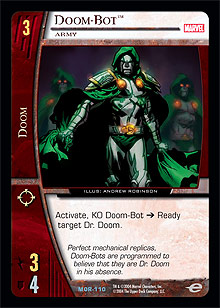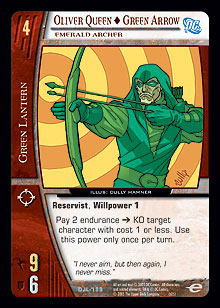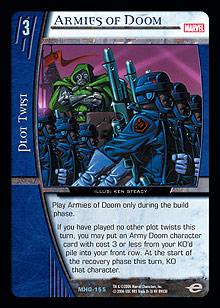Part 1
Welcome back to Deck Clinic. Today’s secret ingredient, in case you’ve forgotten, is Doom.
When we left off, we’d just gone over the bewildering array of characters that Crisis on Infinite Earths and Enemy of My Enemy open up as options for our deck. Now, however, let’s try to put together a character core for the deck and see if we have the space for luxuries like Moloids or “walking plot twists.”
Core Choices
4 Boris, Personal Servant of Dr. Doom
4 Kang, One of Many
1 Doom-Bot, Army
4 Dr. Doom, Richards’s Rival
4 Dr. Doom, Diabolic Genius
1 Dr. Doom, Sorcerous Savant
1 Dr. Doom, Scientific Sorcerer
1 Dr. Doom, Lord of Latveria
First, a few notes on the cuts already made from the original list. Valeria Von Doom, Heir to Latveria doesn’t feel like a strictly necessary card, although we would like to include her for her alternate recruit cost and card-cycling power. Robot Sentry will turn off as soon as we flip Crisis on Infinite Earths, which could make it tricky to use. Kang, One of Many, on the other hand, will almost always be able to use his power. One Doom-Bot, Army seems like the bare minimum to play; with even a single copy of Armies of Doom, more robots would always be welcome. Note that as with Robot Sentry, we can’t actually use Armies of Doom while Crisis on Infinite Earths is face-up in our resource row, so we will need to be careful about the number of Doom team-stamped rather than name-stamped effects we include. In the 6-drop slot, Dr. Doom, Victor Von Doom simply feels outclassed by his newer and shinier Dr. Doom, Sorcerous Savant version. Maxing out on our 3- and 4-drops frees up Faces of Doom to provide more consistent access to the top end of our curve.
This is only twenty characters, which gives us a healthy amount of breathing space for adding some of the off-team characters we’ve been looking at . . . and maybe a few Moloids, too.
Turning to resources, these seem like the most critical plot twists and locations in the deck:
4 Doomstadt, Castle Doom
4 Crisis on Infinite Earths, Team-Up
4 Reign of Terror
4 Mystical Paralysis
4 Faces of Doom
4 Enemy of My Enemy
24 resources gives us Doomstadt, our “engine” card, Reign and Paralysis, and the search card core of the deck—which leaves us a little less space for resources than we have for characters.
 At this point we want to start thinking about which characters and resources to add to our core, which isn’t always as simple as adding a copy of a character or a few copies of a plot twist. For example, if we’re adding more than one copy of Armies of Doom, we want to add extra copies of Doom-Bot, Army and also consider adding something to ensure that we can control whether or not Crisis is face-up. If we want to run Power Compressor, then we’ll want a copy of either Tech Upgrade or Cannibal Tech (which to use will depend on if we can benefit from the discard by discarding Moloids or a Doom-Bot character for Armies of Doom) and a copy of John Henry Irons ◊ Steel, Steel-Drivin’ Man to let us hit Compressor on turn 5 without underdropping.
At this point we want to start thinking about which characters and resources to add to our core, which isn’t always as simple as adding a copy of a character or a few copies of a plot twist. For example, if we’re adding more than one copy of Armies of Doom, we want to add extra copies of Doom-Bot, Army and also consider adding something to ensure that we can control whether or not Crisis is face-up. If we want to run Power Compressor, then we’ll want a copy of either Tech Upgrade or Cannibal Tech (which to use will depend on if we can benefit from the discard by discarding Moloids or a Doom-Bot character for Armies of Doom) and a copy of John Henry Irons ◊ Steel, Steel-Drivin’ Man to let us hit Compressor on turn 5 without underdropping.
Of course, we shouldn’t forget that we may want some more offensive punch, possibly in the form of Savage Beatdown. Expendable Ally is an odd card for a deck like this. On the one hand, if it does anything it will probably be absolutely backbreaking—imagine negating a Roy Harper activation targeting your Sorcerous Savant, giving Dr. Doom +5 ATK, putting him out of range of a second activation, and dealing an extra 10 endurance loss as he attacks twice thanks to a Doom-Bot KO. On the other hand, in many games—and many entire matchups—the card will have no targets whatsoever. It doesn’t feel like it can realistically be a 4-of, but the deck could easily get a lot of mileage out of having the first copy as a Boris target. One last possibility is to add a copy of Teamwork to protect our Crisis from being interfered with (by anyone other than us, that is).
And last but not least, never forget the old stalwarts: utility cards like Flame Trap; Betrayal; Have a Blast!; and Press the Attack could all be worthy of inclusion.
Tech Characters & Resources
We’re building an essentially aggressive deck, so I’m going to skew my choice of tech characters in that direction. I’ll only include general utility or disruptive characters if I think they’re absolutely necessary.
 For my version of the deck, I’m going to choose Oliver Queen ◊ Green Arrow, Emerald Archer as my off-team 4-drop. He has an ATK value comparable to Dr. Doom, Diabolic Genius with the bonus from Doomstadt, Castle Doom, and a great payment power for sniping away invisible women, butlers, policemen, and other nuisances that might impede the good Doctor in his work. Quite often I imagine that we’ll recruit Dr. Doom, Diabolic Genius on turn 4, then follow up with Green Arrow and Boris on 5.
For my version of the deck, I’m going to choose Oliver Queen ◊ Green Arrow, Emerald Archer as my off-team 4-drop. He has an ATK value comparable to Dr. Doom, Diabolic Genius with the bonus from Doomstadt, Castle Doom, and a great payment power for sniping away invisible women, butlers, policemen, and other nuisances that might impede the good Doctor in his work. Quite often I imagine that we’ll recruit Dr. Doom, Diabolic Genius on turn 4, then follow up with Green Arrow and Boris on 5.
At 5 (where two choices seems reasonable, given the lack of a Doom of any kind), Garth ◊ Tempest, Atlantean Sorcerer is just too good to leave out, while Scarecrow, Fearmonger provides aggressive stats along with a potentially useful anti-counter ability and the potential to grow to 6-drop size by the end of the game. One point that may, in play, turn out to be really quite important: Given the likely dominance of Doom characters, Garth allows you to chain two copies of Enemy of My Enemy together, discarding a Doom character for an off-team character, then discarding that off-team character for a needed Doom character. Garth can then fetch back the off-team character from the KO’d pile if needed.
At 6 (the least likely turn to want to recruit a non-Dr. Doom character), I’m going to have a little fun and add possibly the least predictable character imaginable—a character whose chief weapon is fear. Well, fear and surprise. Okay, fine . . . his three weapons are fear, surprise, and ruthless efficiency. Although I can’t quite guarantee that he’ll be as unexpected as the Spanish Inquisition, Satanus, Evil Incarnate should be quite surprising. He even has his own comfy chair! Is it just crazy enough to work? I certainly hope so. Against pure curve decks, a Satanus/5-drop team attack into an opposing 6-drop will produce a quite monstrous shift in the momentum of the game. On the downside, his puny stats make him easy prey for Roy Harper ◊ Arsenal, Sharpshooter, and he is vulnerable to Mystical Paralysis from opposing Doom decks. If you want something a little more conventional, I suggest Gorilla Grodd, Simian Mastermind, who can make good use of your non-Dr. Doom 5-drop to tear a chunk out of your opponent’s formation.
Finally, I’m going to add two different 7-drop characters, since this is the turn with the least impressive version of Dr. Doom. The first will be the super-aggressive Deathstroke the Terminator, Ultimate Assassin, who is capable of swinging in for damage and taking out both a 6-drop and 7-drop. The second will be a new kid on the block, Ronan the Accuser, Supreme Public Accuser, whose triggered power seems like it has the potential to do truly horrific amounts of damage to any number of decks dependent on face-up resources—and all without being as tiny as Psimon.
There’s one big decision left to make for the deck, and I’m honestly not sure about the best way to go. Basically, there is space in the deck for either Kang, One of Many or the means to use Armies of Doom, Doom-Bot, and Moloids (as the Doom-Bot and Moloids really need more than just Enemy of My Enemy as a discard outlet to be reliable). For current Golden Age, with Tim Drake ◊ Robin, Young Detective; Hank Hall ◊ Hawk, Agent of Chaos; and the various High Voltage 1-drops around, I think you may just need the copies of Kang (against High Voltage, he can exhaust 1-drops in response to the recruiting of equipment) and may even need to put back some copies of Robot Sentry despite their lack of synergy with Crisis.
 If we drop Kang, then the slots he frees up do a few things, the first of them indirect; they make Boris a little bit better, as we can now happily draw and play him on turn 2. The second thing they do is direct: they free up slots for Army characters and another discard outlet (Valeria Von Doom, Heir to Latveria), and they make it worth our while to run a copy of Armies of Doom. Regardless of the metagame advantages of the exhaustion 2-drops, I’m going to leave them out for now, going instead for the Armies plan. Reign of Terror; Betrayal; and Flame Trap can all give us options against decks like Titans and High Voltage, and unlike other control decks, Crisis Doom can actually threaten to put High Voltage quite badly negative on endurance on turn 6 with a double-attacking Dr. Doom, Sorcerous Savant.
If we drop Kang, then the slots he frees up do a few things, the first of them indirect; they make Boris a little bit better, as we can now happily draw and play him on turn 2. The second thing they do is direct: they free up slots for Army characters and another discard outlet (Valeria Von Doom, Heir to Latveria), and they make it worth our while to run a copy of Armies of Doom. Regardless of the metagame advantages of the exhaustion 2-drops, I’m going to leave them out for now, going instead for the Armies plan. Reign of Terror; Betrayal; and Flame Trap can all give us options against decks like Titans and High Voltage, and unlike other control decks, Crisis Doom can actually threaten to put High Voltage quite badly negative on endurance on turn 6 with a double-attacking Dr. Doom, Sorcerous Savant.
Moving on to resources, the main resource I’m going to add that was absent from the original deck is a card I haven’t put in a deck for far too long. We’re a curve deck, we’re legal in Golden Age, and we want to smash things? Savage Beatdown. Four copies. Doesn’t that make you feel all warm and tingly inside? As for singleton Boris targets, my list will include the Armies of Doom we’ve been looking forward to so much, along with Flame Trap (also a discard outlet for our Army drops); Betrayal; and Expendable Ally. Betrayal is your trump against decks like High Voltage, because you can play even a single copy a quite revolting number of times in a game. Check it out:
Turn 3: Recruit Dr. Doom, Richards’s Rival, putting Betrayal on top of the deck.
Turn 4: Draw Betrayal, put it in the resource row, and play it. Recruit Dr. Doom, Diabolic Genius, turning Betrayal face down.
Turn 5: Recruit Garth ◊ Tempest, Atlantean Sorcerer, play Betrayal, replace it with 3-drop Doom’s payment power, pay 3 endurance to get Betrayal back, and play it again.
Turn 6: Pay 3 endurance to get Betrayal back again, put it in the row, play it, recruit Dr. Doom, Sorcerous Savant, and KO a character to turn Betrayal face down again before playing it one last time.
Congratulations; you just played a single copy of Betrayal five times across three turns. You may never need to stun a single character in combat against High Voltage; your only concern is to smash face fast enough to kill your opponent, probably on turn 6.
Final List
So, we come to the final list. Even more than the average Deck Clinic list, this one is adaptable to any whim—the nature of the Crisis/Enemy toolbox gives almost unlimited access to the weirdest tech characters you can think of. Boris and Dr. Doom, Richards’s Rival also give reliable access to tech plot twist slots, and to equipment via plot twist search like Cannibal Tech. The only cards that can’t be searched for easily are locations, and even then, Mystical Paralysis can make Amadeus Arkham, Architect of Insanity extremely reliable. If you do add location search, I recommend at least one copy of Doom’s Throne Room. With the sheer number of plot twists in the deck and the benefits to be gained from discarding the Army characters, it would have been nice to fit it into the final build of the deck. Again, the Throne Room is another card that needs careful handling in conjunction with Crisis. If you add one of the location-searching 2-drops (Poison Ivy, Deadly Rose; Kelex, Faithful Servant; or San, The Alienated One), you may also want to add a copy of Latveria to enable Reign of Terror on turn 3. See? I’m about to give you a final list, and I’m still talking about different ways to take the deck. I’m in danger of turning this into Pimp My Deck, installing a 30” plasma screen under the hood, waterproofing the accelerator and brake pedals, and installing a driver’s foot spa. I better give you a list before I go completely off the rails.
Characters
3 Moloids, Army
4 Boris, Personal Servant of Dr. Doom
3 Valeria Von Doom, Heir to Latveria
4 Dr. Doom, Richards’s Rival
1 Doom-Bot, Army
4 Dr. Doom, Diabolic Genius
1 Oliver Queen ◊ Green Arrow, Emerald Archer
1 Garth ◊ Tempest, Atlantean Sorcerer
1 Scarecrow, Fearmonger
1 Dr. Doom, Sorcerous Savant
1 Satanus, Evil Incarnate (Okay, okay, “or Grodd.”)
1 Dr. Doom, Scientific Sorcerer
1 Deathstroke the Terminator, Ultimate Assassin
1 Ronan the Accuser, Supreme Public Accuser
1 Dr. Doom, Lord of Latveria
Plot Twists
4 Crisis on Infinite Earths
4 Reign of Terror
4 Mystical Paralysis
4 Savage Beatdown
4 Enemy of My Enemy
4 Faces of Doom
1 Expendable Ally
1 Flame Trap
1 Betrayal
1 Armies of Doom
Locations
4 Doomstadt, Castle Doom
I hope you enjoyed this journey through some of the dustier nooks and crannies of Doom’s castle (and, judging by the final character roster, some kind of bizarre, inter-dimensional Yellow Pages).
Before I sign off, vsdeckclinic@googlemail.com is where you can reach me with your ideas. Golden, Silver, or the new-and-improved Combined Modern Age format—from casual to competitive—I’m open to submissions across the whole spectrum of deckbuilding. I’ll be looking forward to seeing what you’ve come up with, but until next time, think about putting some more Doom in your diet!
Tom Reeve is a member of the Anglo-Canadian Alliance (like the Rebel Alliance, but with public transport instead of X-Wings) and would-be professional layabout from London, England. While his love of all things ninja has resulted in an arguably unhealthy affinity for the League of Assassins, that particular quirk turned into a healthy plus with the birth of the Silver Age deck Deep Green, with which teammate Ian Vincent took home the Pro Circuit San Francisco trophy to dear old Blighty.